Method and apparatus for streaming force values to a force feedback device
a technology of force feedback and interface device, which is applied in the direction of mechanical control device, manual control with single controlling member, instruments, etc., can solve the problems of large and heavy actuators, large size, weight, and power consumption of actuators, and achieve the effect of less complex forces and minimal reduction in the realism of generated forces
- Summary
- Abstract
- Description
- Claims
- Application Information
AI Technical Summary
Benefits of technology
Problems solved by technology
Method used
Image
Examples
Embodiment Construction
[0029]FIG. 1 is a block diagram illustrating an interface system 10 of the present invention for a force feedback interface device controlled by a host computer system. Interface system 10 includes a host computer system 12 and an interface device 14.
[0030]Host computer system 12 is preferably a personal computer, such as an IBM-compatible or Macintosh personal computer, or a workstation, such as a SUN or Silicon Graphics workstation. For example, the host computer system can a personal computer which operates under the MS-DOS or Windows operating systems in conformance with an IBM PC AT standard. Alternatively, host computer system 12 can be one of a variety of home video game systems commonly connected to a television set, such as systems available from Nintendo, Sega, or Sony. In other embodiments, home computer system 12 can be a television “set top box” or a “network computer” which can be used, for example, to provide interactive computer functions to users over networks.
[0031...
PUM
 Login to View More
Login to View More Abstract
Description
Claims
Application Information
 Login to View More
Login to View More - R&D
- Intellectual Property
- Life Sciences
- Materials
- Tech Scout
- Unparalleled Data Quality
- Higher Quality Content
- 60% Fewer Hallucinations
Browse by: Latest US Patents, China's latest patents, Technical Efficacy Thesaurus, Application Domain, Technology Topic, Popular Technical Reports.
© 2025 PatSnap. All rights reserved.Legal|Privacy policy|Modern Slavery Act Transparency Statement|Sitemap|About US| Contact US: help@patsnap.com



